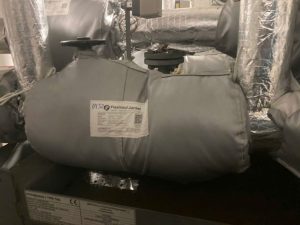Periodic inspection of removable insulation jackets (or insulation blankets) is essential to ensure operational safety, optimize energy efficiency, and extend the lifespan of plant equipment. A detailed checklist helps standardize the process, ensuring no critical items are missed and potential damage is detected early.
Why is periodic inspection of insulation jackets necessary?
Over time, insulation jackets can degrade due to physical impact, chemicals, moisture, or high temperatures. Neglecting inspections can lead to several serious consequences:
- Energy Waste: Damaged insulation jackets reduce thermal efficiency, leading to heat loss and increased operational costs.
- Safety Hazards: Overheated equipment surfaces can cause severe burns to operating personnel.
- Equipment Corrosion: Moisture trapped under the insulation is a leading cause of Corrosion Under Insulation (CUI), which damages pipes and machinery.
- Increased Replacement Costs: Minor damages that are not addressed promptly can spread, requiring costly replacement of the entire insulation jacket.
The 10-Point Insulation Jacket Inspection Checklist
Below are 10 detailed items to help you comprehensively assess the condition of the insulation jacket system in your facility.
1. Inspect the Outer Fabric Surface
Carefully observe the entire surface of the jacket. Look for any unusual signs such as tears, punctures, frayed fabric, or split seams. These are the most vulnerable areas.
2. Detect Deformations and Bulging
The insulation jacket’s surface should be flat and fit snugly against the equipment. Areas that are bulging, sagging, or deformed may indicate that the internal insulation material has compressed, settled, or become wet.
3. Look for Stains and Signs of Corrosion
Check for signs of chemicals, oil, or grease that have soaked into the jacket’s surface. Unusual stains or discoloration of the fabric can be a warning sign of leaks from the equipment or environmental exposure.
4. Check the Strapping and Fastening System
Ensure all straps are intact, tightened securely, and not loose. Inspect fasteners (hooks, D-rings) for rust, cracks, or deformation, as they can fail and cause the jacket to come loose.
5. Ensure Correct Installation and Positioning
The insulation jacket must be installed in its designed position, completely covering the component that needs insulating (valve, pipe, flange, etc.). The seams must be tight, with no gaps that could cause heat loss.
6. Assess Firmness and Resilience
Using a gloved hand, press gently on different areas of the jacket’s surface. Feel the resilience of the material inside. If it feels too soft or hollow, the insulation material may have degraded.
7. Identify Unusual “Hot Spots”
Use an infrared thermometer or a thermal imaging camera to scan the surface of the insulation jacket. “Hot spots” with significantly higher temperatures than the surrounding areas are a clear sign that the insulation capability in that location has been severely compromised.
8. Find Signs of Moisture, Mold, or Leaks
Closely inspect seams and low-lying areas of the jacket for stains, discoloration, or signs of mold. This is evidence that moisture has penetrated and accumulated inside, posing a risk of CUI.
9. Evaluate Environmental Impacts
Check if any nearby pipes or valves are leaking steam, water, or chemicals that could directly impact the insulation jacket. Also, identify areas with a high risk of mechanical impact (near walkways, forklift traffic areas).
10. Document and Classify Damage
After the inspection, create a report documenting the location, a detailed description, and photos of any damage. Classify the priority level:
- High: Requires immediate repair/replacement (large tears, overheated surface).
- Medium: Plan to address during the next maintenance cycle (loose straps, minor stains).
- Monitor: Record for closer inspection during the next check.
Adhering to this checklist not only helps maintain system performance but is also a crucial part of the plant’s safety culture. If you detect damage or need professional insulation solutions, contact experts for assistance.
Request consultation and quotation now!Frequently Asked Questions
How often should insulation jacket systems be inspected?
It depends on the operating environment. A visual inspection is recommended quarterly, and a detailed inspection with tools (like a thermal camera) should be done at least annually.
What are the most common signs of a damaged insulation jacket?
Common signs include tears or punctures, loose or broken straps, unusually high surface temperatures (hot spots), and moisture stains.
When does an insulation jacket need to be completely replaced?
Replacement is necessary for severe, irreparable physical damage, a significant drop in insulation performance, or when signs of CUI are detected underneath.
What is Corrosion Under Insulation (CUI)?
CUI (Corrosion Under Insulation) is corrosion that occurs on the metal surface of pipes or equipment when moisture becomes trapped beneath the insulation material. It is a serious and often hidden problem.










